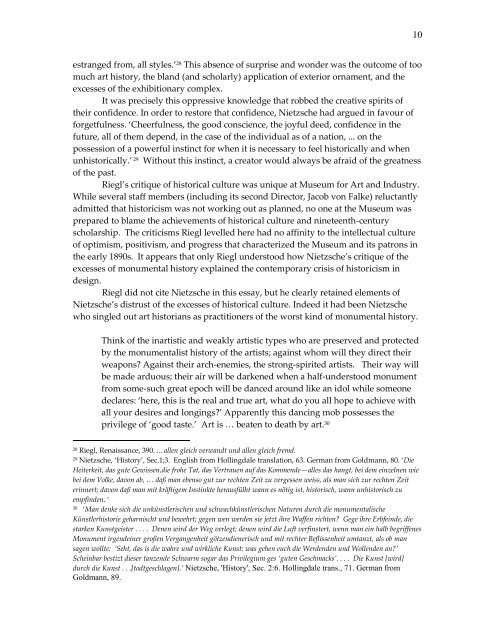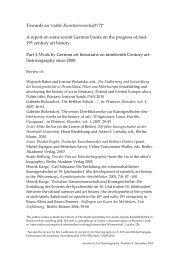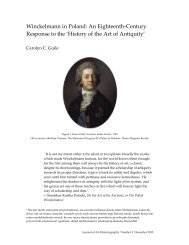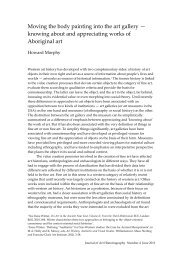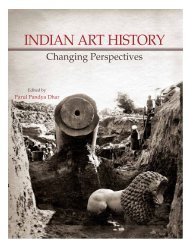The advantages and disadvantages of Art History to Life: Alois Riegl ...
The advantages and disadvantages of Art History to Life: Alois Riegl ...
The advantages and disadvantages of Art History to Life: Alois Riegl ...
Create successful ePaper yourself
Turn your PDF publications into a flip-book with our unique Google optimized e-Paper software.
estranged from, all styles.’ 28 This absence <strong>of</strong> surprise <strong>and</strong> wonder was the outcome <strong>of</strong> <strong>to</strong>o<br />
much art his<strong>to</strong>ry, the bl<strong>and</strong> (<strong>and</strong> scholarly) application <strong>of</strong> exterior ornament, <strong>and</strong> the<br />
excesses <strong>of</strong> the exhibitionary complex.<br />
It was precisely this oppressive knowledge that robbed the creative spirits <strong>of</strong><br />
their confidence. In order <strong>to</strong> res<strong>to</strong>re that confidence, Nietzsche had argued in favour <strong>of</strong><br />
forgetfulness. ‘Cheerfulness, the good conscience, the joyful deed, confidence in the<br />
future, all <strong>of</strong> them depend, in the case <strong>of</strong> the individual as <strong>of</strong> a nation, ... on the<br />
possession <strong>of</strong> a powerful instinct for when it is necessary <strong>to</strong> feel his<strong>to</strong>rically <strong>and</strong> when<br />
unhis<strong>to</strong>rically.’ 29 Without this instinct, a crea<strong>to</strong>r would always be afraid <strong>of</strong> the greatness<br />
<strong>of</strong> the past.<br />
<strong>Riegl</strong>’s critique <strong>of</strong> his<strong>to</strong>rical culture was unique at Museum for <strong>Art</strong> <strong>and</strong> Industry.<br />
While several staff members (including its second Direc<strong>to</strong>r, Jacob von Falke) reluctantly<br />
admitted that his<strong>to</strong>ricism was not working out as planned, no one at the Museum was<br />
prepared <strong>to</strong> blame the achievements <strong>of</strong> his<strong>to</strong>rical culture <strong>and</strong> nineteenth-century<br />
scholarship. <strong>The</strong> criticisms <strong>Riegl</strong> levelled here had no affinity <strong>to</strong> the intellectual culture<br />
<strong>of</strong> optimism, positivism, <strong>and</strong> progress that characterized the Museum <strong>and</strong> its patrons in<br />
the early 1890s. It appears that only <strong>Riegl</strong> unders<strong>to</strong>od how Nietzsche’s critique <strong>of</strong> the<br />
excesses <strong>of</strong> monumental his<strong>to</strong>ry explained the contemporary crisis <strong>of</strong> his<strong>to</strong>ricism in<br />
design.<br />
<strong>Riegl</strong> did not cite Nietzsche in this essay, but he clearly retained elements <strong>of</strong><br />
Nietzsche’s distrust <strong>of</strong> the excesses <strong>of</strong> his<strong>to</strong>rical culture. Indeed it had been Nietzsche<br />
who singled out art his<strong>to</strong>rians as practitioners <strong>of</strong> the worst kind <strong>of</strong> monumental his<strong>to</strong>ry.<br />
Think <strong>of</strong> the inartistic <strong>and</strong> weakly artistic types who are preserved <strong>and</strong> protected<br />
by the monumentalist his<strong>to</strong>ry <strong>of</strong> the artists; against whom will they direct their<br />
weapons? Against their arch-enemies, the strong-spirited artists. <strong>The</strong>ir way will<br />
be made arduous; their air will be darkened when a half-unders<strong>to</strong>od monument<br />
from some-such great epoch will be danced around like an idol while someone<br />
declares: ‘here, this is the real <strong>and</strong> true art, what do you all hope <strong>to</strong> achieve with<br />
all your desires <strong>and</strong> longings?’ Apparently this dancing mob possesses the<br />
privilege <strong>of</strong> ‘good taste.’ <strong>Art</strong> is … beaten <strong>to</strong> death by art. 30<br />
28 <strong>Riegl</strong>, Renaissance, 390. ... allen gleich verw<strong>and</strong>t und allen gleich fremd.<br />
29 Nietzsche, ‘<strong>His<strong>to</strong>ry</strong>’, Sec.1;3. English from Hollingdale translation, 63. German from Goldmann, 80. ‘Die<br />
Heiterkeit, das gute Gewissen,die frohe Tat, das Vertrauen auf das Kommende—alles das hangt, bei dem einzelnen wie<br />
bei dem Volke, davon ab, … daß man ebenso gut zur rechten Zeit zu vergessen weiss, als man sich zur rechten Zeit<br />
erinnert; davon daß man mit kräftigem Instinkte herausfülht wann es nötig ist, his<strong>to</strong>risch, wann unhis<strong>to</strong>risch zu<br />
empfinden. ‘<br />
30 ‘Man denke sich die unkünstlerischen und schwachkünstlerischen Naturen durch die monumentalische<br />
Künstlerhis<strong>to</strong>rie geharnischt und bewehrt; gegen wen werden sie jetzt ihre Waffen richten? Gege ihre Erbfeinde, die<br />
starken Kunstgeister . . . . Denen wird der Weg verlegt; denen wird die Luft verfinstert, wenn man ein halb begriffenes<br />
Monument irgendeiner großen Vergangenheit götzendienerisch und mit rechter Beflissenheit umtanzt, als ob man<br />
sagen wollte: ‘Seht, das is die wahre und wirkliche Kunst: was gehen euch die Werdenden und Wollenden an?’<br />
Scheinbar bestizt dieser tanzende Schwarm sogar das Privilegium ges ‘guten Geschmacks’. . . . Die Kunst [wird]<br />
durch die Kunst . . .[<strong>to</strong>dtgeschlagen].’ Nietzsche, '<strong>His<strong>to</strong>ry</strong>', Sec. 2:6. Hollingdale trans., 71. German from<br />
Goldmann, 89.<br />
10


